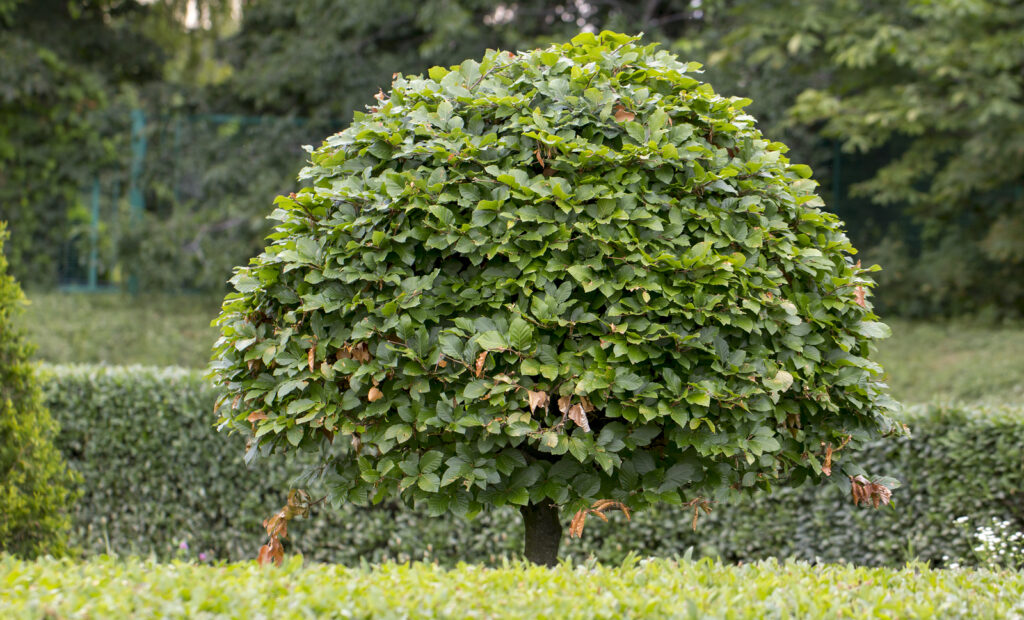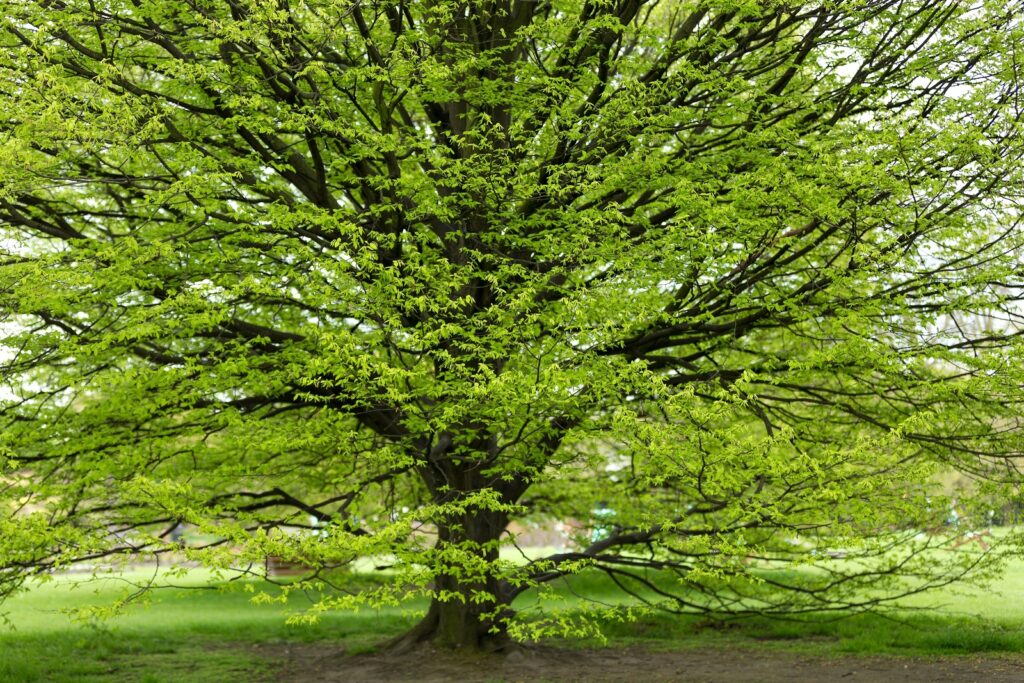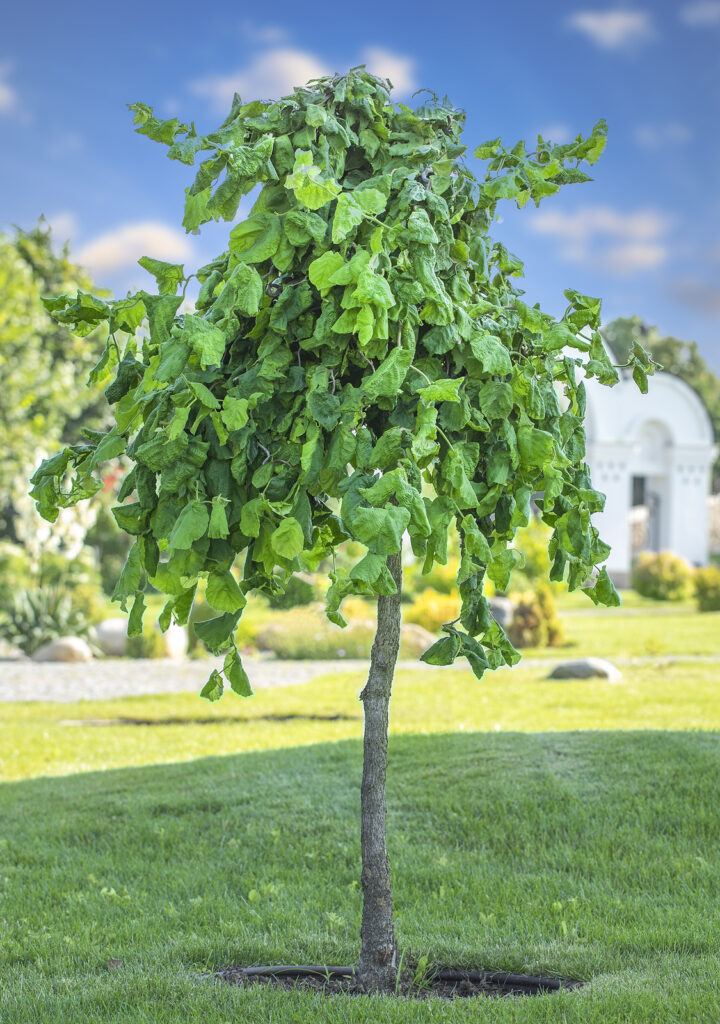Hornbeams are well-behaved and handsome deciduous trees. They are long-lived. Trunks and large limbs are covered with smooth gray bark. Hornbeams can be planted as street trees, in large lawns, and in woodland gardens. They can be shaped into formal hedges or pollarded to form tight canopies.
Hornbeam is the common name for the genus Carpinus which is a member of the Birch Family. Hornbeams are of irregular form with delicate wiry twigs, smooth, beech-like bark, tendon-like swellings along the trunk and lower limbs, and handsome light green fruit clusters.
Hornbeams have rounded heads of good foliage, rarely subject to insect attacks and they assume attractive autumn tints. The withered leaves hang on the trees through the winter, providing excellent cover for birds.
Hornbeam wood is exceedingly hard, justifying the common name Ironwood. The wood was once used to make ox yokes and it takes on a glossy, horn-like polish.
Some species of hornbeam can stand severe pruning and have long been used for hedges in formal gardens. Although they grow slowly, they are hardy and are also of value as specimens on the lawn or in park plantings.

Get to know Hornbeam
- Plant type: Deciduous tree
- Growing Zones and range: 3-9 depending on the variety
- Hardiness: Cold hardy
- Height and spread: 20’ to 60’ tall and wide depending on variety; upright oval form
- Foliage: Serrated green leaves turn yellow, orange, and red in fall
- Flowers: Yellowish green flowers in catkins in early to mid-spring.
- Bloom time: Early to mid-spring
- Uses: Street tree, lawns, near patios, woodland
- Common name: Hornbeam
- Botanical name: Carpinus spp.
- Family: Betulaceae
- Origin: Woodlands of Europe, Asia, North America
Where to plant Hornbeam
- Plant hornbeam in full sun to partial shade.
- Grow hornbeam in deep, humus-rich soil that’s slightly acidic. Hornbeams thrive in moist soil but will tolerate dry ground

When to plant Hornbeam
- Set container-grown hornbeam in the garden in spring.
- Hornbeams are difficult to transplant once established.
Planting and spacing Hornbeam
- Space hornbeam with the size of the tree at maturity in mind.
How to water and feed Hornbeam
- Keep the soil evenly moist; regular water will keep the tree vigorous. Hornbeam does not tolerate soggy soil.
- Fertilize hornbeam with all-purpose fertilizer in spring.
Hornbeam care
- Prune hornbeam in winter.
- Hornbeams can be trained into formal hedges. They can be pollarded into tight, formal canopies.
Hornbeam common problems
- Hornbeam is difficult to transplant.
- Hornbeam is susceptible to scale infestation.

Hornbeam propagation
- Sow seed in fall.
- Graft in late winter or early spring.
Hornbeam varieties to grow
- American hornbeam, Carpinus caroliniana: Zone 3-9; 20 to 30 feet tall and wide; slow-growing, long-lived; wide oval form; leaves turn yellow, orange, red in fall; tolerates wet, boggy soil.
- European hornbeam, Carpinus betulus; Zones 4-7; 40 to 60 feet tall, 30 to 40 feet wide; branches arranged around the trunk like a spiral staircase; dense canopy; grows in full sun or partial shade; ‘Asplenifolia’ deeply lobed leaves; ‘Columnaris’ columnar form; ‘Fastigiata’ vase-shaped tree.
- Japanese hornbeam, Carpinus japonica; Zones 5-8; a small pyramidical tree with wide-spreading branches and furrowed bark; leaves turn red in fall.















